MediBloc -Changing the medical data storage industry by rexdickson
PREFACE
Over the past years, it is evident that every major industry has invested heavily in technology and computerization. Relative to a decade ago, today more humans buy airline tickets and check in to flights online, purchase goods on the internet and even obtain degrees online in various disciplines. Yet, despite these advances in our society, the majority of patients are given handwritten medical prescriptions, and very few patients are able to email their physician, schedule an appointment to see a provider without speaking to a live or have total control over their own personal health data. Thus, the EHR or EMR was invented.
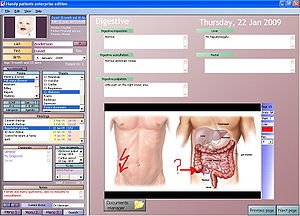
An Electronic Health Record(EHR), or Electronic Medical Record(EMR) is the computerized systematic collection of patients health information, electronically-stored in a digital format. These records can be shared between different settings. Above is a Sample View of an Electronic Health Record[EHR] -Wikipedia.
These information are shared through network-connected, enterprise-wide information systems or other information networks and exchanges. EHRs or EMRs may include a range of data like demographics, medical history, medication, allergies, immunization status, laboratory test results, radiology images, vital signs, personal statistics like age and weight, billing information and insurance data.
Electronic health record (EHR) systems had the potential to transform the health care system from a mostly paper-based industry to one that utilizes clinical and other pieces of information to assist providers in delivering higher quality of care to their patients. The contemporary medical system is increasing relying and needing the complex and sophisticated Health Informatics technology of the EHR to perform various tasks ranging from collection of data to total control of data. But the EHR is popularly and mainly bugged by
•High cost and Lack of storage capacity due to centralization
•Slow adaptability and waste of time
•Lack of confidentiality and privacy due to centralization
All these weakened the Health Informatics and data storage system of the medical industry.
Medical records are subjects too to stringent privacy laws under the EHR system like the IPAA laws. As these laws protect the privacy of the patients, these laws also obstruct the patient from having total control over their data and also obstruct in the care of the patients and data analysis.
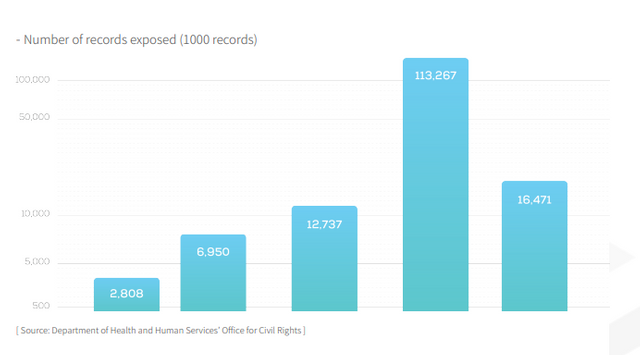
Susan Frampton, president of Planetree talks about the EHR health care system, she says “It continues to be a struggle to create a truly patient-centered approach to the electronic health record…. there’s been very little integration or involvement of patients and what they would like to have captured”.
This is really sickening.
But then, we all want a system where we can have autonomous access and total control over our medical data and a system where our Health Informatics is centered totally on our needs rather than that of the government or national health centers.
Well, MediBloc offers that through the blockchain technology.
MediBloc

Is a medical technology company building a decentralized personal health record(PHR) platform on the blockchain. A Personal Health Record (PHR) is an electronic application for recording personal medical data that the individual patient controls and may make available to healthcare providers.

MediBloc aims to overcome the barriers of the electronic health data sector by bringing together the scattered pieces of patients data and making the system customer-centered through the introduction and harnessing of PHR as opposed to the traditional EHR system. This is evolving the Healthcare data system from just being a data exchange platform to becoming a mutli-purposed platform.
It is however pertinent to note that, MediBloc does NOT aim to eliminate the EHR system but only make it better through PHR.
MediBloc changes the healthcare medical data industry in some many ways, some of which are:
•Data Integration and Patient Generated Health Record(PGHR) and Digital Healthcare Wallet:
This is where data can be stored and concurrently updated then retrieved for use or for sale to research institutions.
•Automatic insurance claim through smart contracts
•Exchange of medical data for tokens
•MediBloc Chatbox:
A smartphone application where AI(artificial intelligence) is employed to offer professional healthcare advice, recommend treatment, prescribe diagnosis and predict prognosis to users. Users can also be linked to the best and right medics on the platform through the MediBloc Chatbox.
•SNS(Social Networking Services):
This is a platform where patients can interact with each other and with medical practitioners thereby creating a medical decentralized virtual community that will benefit patients, research institutions and medical practitioners.
•Telemedicine:
This enables patients to overcome the physical barriers and connect to the proper medical service anywhere in the workday anytime of the day.



How will the Data Storage Issue be resolved to reduce high cost?
MediBloc resolves this by disrupting the traditional healthcare system through data integration. It stores data in a decentralized database where users can access their information without needing companies or corporations to give them access thereby charging them. It is known that what gets recorded onto the blockchain is it’s hashed value. In a nutshell, when healthcare data is stored in the MediBloc , the hashed value on MediBloc is saved on blockchain. Healthcare data will be stored in a distributed database outside the blockchain. Personal information and medical information is encrypted and stored using a private key, giving total ownership and access to the customer. Thus, there will also be a reduction in costs by storing data outside of the blockchain.





MediBloc dissolves the problem of lack of security and threats of hacking by giving patients autonomous power over their data control instead of public corporation by decentralizing the system through blockchain technology. The patients will have the right to decrypt, store and collect all these information through the blockchain. MediBloc produces transparency by recording the activities of anyone who accessed the information on the blockchain, thus giving the users or customers more knowledge about the safety of their data therefore eliminating the exploitation of the user’s or customers data.
Moreover, the decentralized data storage prevents data loss and MediBloc also continuously generate backup data, verifies the data and retrieved it if lost. Thus, only verified medical practitioners and medical institutions, if permitted, will have access to a patient's data.


Moreover, who doesn’t want to be in full control over their data? Like the medical records?
I think everybody want to.
But then, how impactful can this be?
Imagine having your medical data a click away and having the liberty of choosing over who can access to it. Coupled with the incentive that one can exchange it for tokens to research institutions linked on the platform if you wish to. This goes a long way in eliminating fraud and other leaks of the medical data industry.
One won’t need to go for tests in new hospitals but rather, one would just give the hospital a specific level of access to the information. There are different access levels one can choose to give to hospitals or research institutions depending on the need and user’s discretion.
Even in case of emergencies, the level of access make it possible for family members or next of kin to make decisions on behalf of the user about how the data is to be used or accessed.
The MediBloc account comprises of 3 types of account that can be created on the MediBloc platform, which are
•General users
•Healthcare providers
•Data researchers
The level of accessibility to each account varies. And the table below explains it further
.png)


More so, smart contracts on the platform will be the facilitator of transactions between patients and insurance companies. Patients would no longer need to call companies to ask if certain diseases or checkups will be covered as these are automated using the smart contracts. Also, after treatments, patients won’t need to submit claims because the smart contracts used after the tr, eatments enables billing of the patients insurance plan according to the medical data provided by MediBloc .
Data analysis is promoted by the advanced features employed by MediBloc and the autonomous control of data by individuals. Through the platform, researchers will have first hand information from the patients themselves and the researchers too, can gain from the personal experiences of these patients as there will be a direct means of communication between them. This will go a far way in helping with research and data analysis for the betterment of the health sector.
The medical field will be more connected in terms of data and information and because of this rich and personalized flow of information, it will bring unprecedented growth and development through research and speedy treatment of patients.


In as much as the PHR adopted by MediBloc eliminates the loopholes created by the basic EHR or EMR system, the digital means of storage as a whole is better than the traditional paper storage method in terms of:
Legibility
As most doctors have reputation for poor penmanship, only few people outside the field can interpret clearly what was written. Paper medical records can be difficult to decipher, particularly for those unfamiliar with medical terminology. One of the clear benefits of electronic records is that type fonts are more or less standardized and clear across all records. This clarity saves time for the reader, and time is critical in medical treatment.
Editing problems
If you want to make changes to a paper-based record, you will need to photocopy the original first - otherwise you will ruin it with editing corrections.
This will need to be repeated every time you want to make more amendments and you may end up running out of space if significant alterations are required. This is unlike the digital system where one can erase and retype corrections just like I’m doing now using the word processor.
Security
Paper records are generally unsafe because someone can physically break into a storage unit. This type of record is susceptible to natural disasters such as fires and flood. Unlike an electronic or digital version where files can’t stolen by burglary.
Storage
Storage of medical records with Personal Health Record(PHR) have the edge over the traditional paper system. Hospitals and medical providers often have warehouses literally filled with paper records. Besides taking up space, paper records are not eco-friendly. Electronic records can be stored on computer drives that require much less space and fewer resources to produce. Paper records also naturally deteriorate over time in storage, regardless of how well their environment is controlled, and they tend to decay upon excessive handling. Medical computer records can be stored and accessed forever, without the deterioration of record quality.
Access
One of the main benefits of digital medical record system that is perfected by MediBloc PHR is that they can be shared with professionals or institutions almost instantaneously via electronic transmission or via the blockchain. For paper records to reach other interested parties, they must either be mailed or converted to electronic format, such as via scanning and emailing, before they can be accessed.
There is also this problem of inefficient transport system in the paper system. Transferring data in a paper-based system is often problematic. While it is possible to fax, courier or deliver files in person, this is slow and inefficient in the health sector.
This is particularly evident if you need to send over numerous pages of a patient’s data for analysis. With an electronic document management system, users can simply add attachments to an email and send information instantly.
Cost
Amongst the biggest drawbacks in the medical paper-based storage system is the associated costs of supplying writing materials.
Not only will you need lots of paper - usually in different sizes and shapes - you'll require more printers, stationeries and other office supplies frequently.
This high cost is eliminated in the digital system of the MediBloc PHR.
Limited collaboration
Collaboration with other medical establishments or research institutions on documents is extremely hard when working with paper versions.
If several department heads need to go through and approve a document, they must have multiple copies printed, make corrections separately and then share their version with each other before pursuing further changes. MediBloc and the digital system dissolves this problem by the utilization of technology to make e-copies of records and instantaneously transfer them for research in other institutions.
These drawbacks vividly mirror why and how the digital data storage system and the PHR system of MediBloc in the blockchain is better than the traditional paper system.


Use Case
Mr. A has a terminal disease and has a personal doctor that his goes to for regular checkups and medications. He is not comfortable with the regular test injections he gets whenever he leaves town and is attended to by other doctors. He joins MediBloc and gets all his medical data on his smartphone. With MediBloc , he meets others on the social platform who suffers from the same illness and they discuss and share experiences which helps Mr. A scale through his therapies. He also gets to meet other medical professionals on the platform and they give him professional advice too. Mr. A doesn’t need to search for medics anymore whenever he’s out of town; MediBloc has taken care of providing the best nearest medical practitioners on the blockchain for him. Eventually, Mr. A is approached by research institutions who want to use his medical data for research and they offer to reward him with MED tokens for the information, he weighs the options and gladly agrees while giving the institutions limited access to his data at his own discretion.


MediBloc Token
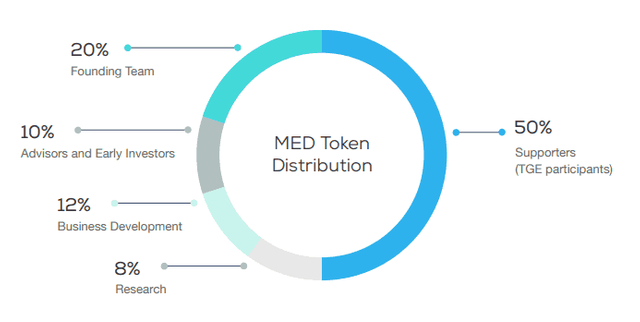
The MediBloc ecosystem runs on two tokens -MED and MEDX.

The Token(MED) will be used for exchanges between MediBloc users and others outside the MediBloc blockchain.
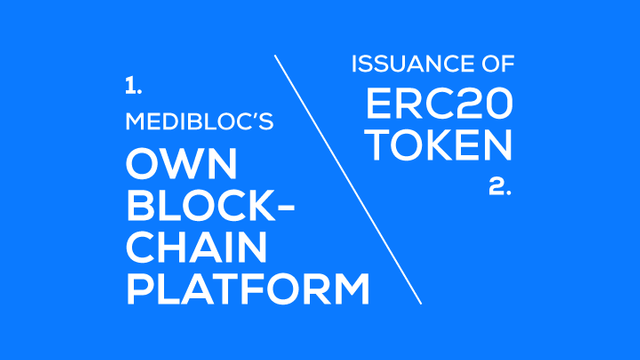
.
The Roadmap
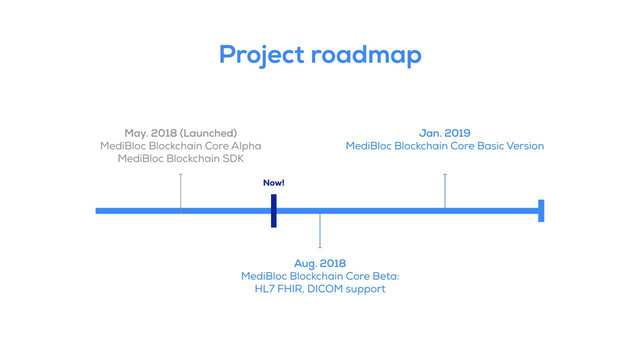.png)
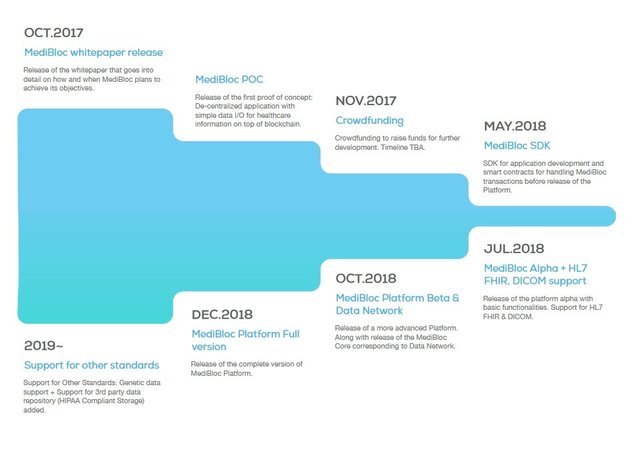
MediBloc Partnerships
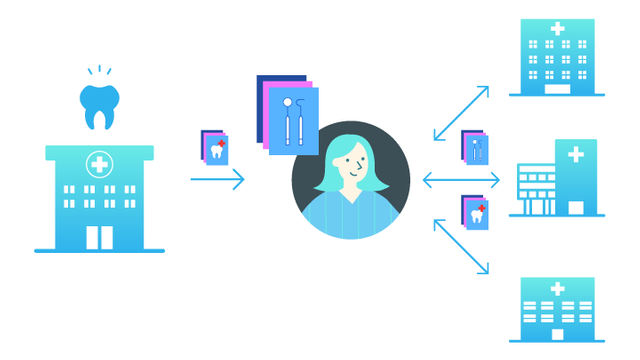

MediBloc is partnering with various reputable companies ranging from healthcare to accounting for easy integration into the system once the mainnet is launched. This will give it more access to be potential customers.
See some of the partners below



SYNOPSIS
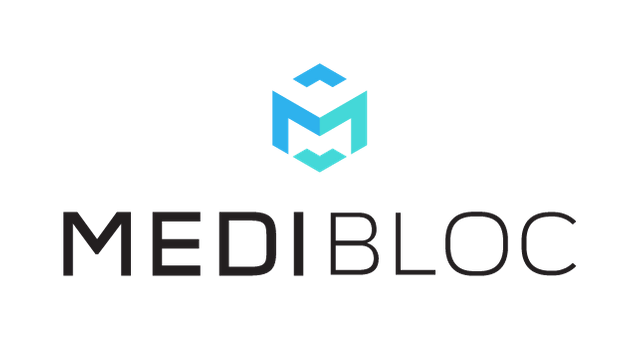
MediBloc is ushering the digital medical data industry into a new phase. With awesome and unique features like maximum security, high reliability, high level of transparency, high interoperability, high accessibility and Data Integration and Patient Generated Health Record(PGHR), MediBloc ensures the total safety of patient users data while making them the center of concern in the blockchain. They ensure that the user’s data is handy, just a click away and can be exchanged for tokens(MED tokens) with companies on the blockchain. They cover the loopholes and limitations of the EHR system by adopting and upgrading the PHR system of medical data storage system. Generally, it betters the health industry in terms of data transfer and management and ensures the speedy obtaining and recovery of data. MediBloc is the new face of the medical data storage industry.
Watch my video about this blockchain platform below


Watch the short introduction video by
MediBloc below
MediBloc is listed on
•Kryptono
•Dex.top
•Gate.io
•IDEX
•Cashierest
For more information, you can visit these sites:
MediBloc Website
MediBloc Whitepaper{English}
MediBloc FAQ
MediBloc Medium
MediBloc Twitter
MediBloc Facebook
MediBloc GitHub
MediBloc Telegram
MediBloc About -Contains media kits with various graphics
The Team


The Advisors

Note: Unless otherwise stated, all pictures or media used herein are gotten from MediBloc sites and are licensed for use in this contest.
medibloc2018
I'm going to download if secure thank for info
Since I've been researching healthcare app development companies for healthcare data integration, Interexy seems to stand out for its healthcare mobile app development services. The fact that they design, develop, test and launch is a huge plus for clinic patients and medical startups looking to enter the digital healthcare space.